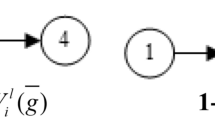Abstract
Recently, it has been shown that networks with an arbitrary degree sequence may be a stable solution to a network formation game. Further, in recent years there has been a rise in the number of firms participating in collaborative efforts. In this paper, we show conditions under which a graph with an arbitrary degree sequence is admitted as a stable firm collaboration graph.


Similar content being viewed by others
Data Availability
Data sharing not applicable to this article as no datasets were generated or analysed during the current study.
Notes
Each firm is not explicitly placed on the transport network, but its location may be implied through the \(s_{li}\) values
References
Belleflamme P, Bloch F (2004) Market sharing agreements and collusive networks. Int Econ Rev 45(2):387–411
Dafermos S, Nagurney A (1987) Oligopolistic and competitive behavior of spatially separated markets. Reg Sci Urban Econ 17(2):245–254
Dutta B, Mutuswami S (1997) Stable networks. J Econ Theo 76(2):322–344
Friesz T, Meimand A (2021) Computable models of dynamic spatial oligopoly from the perspective of differential variational inequalities. Handbook Reg Sci 301–324
Friesz T, Mookherjee R, Rigdon M (2005) An evolutionary game-theoretic model of network revenue management in oligopolistic competition. J Revenue Pricing Manag 4(2):156–173
Friesz TL, Rigdon MA, Mookherjee R (2006) Differential variational inequalities and shipper dynamic oligopolistic network competition. Transp Res B: Methodol 40(6):480–503. https://doi.org/10.1016/j.trb.2005.07.002
Friesz T, Tobin R, Smith T, Harker P (1983) Nonlinear complementarity formulation and solution procedure for the general derived demand network equilibrium problem. J Reg Sci 23(3):337–359
Goyal S, Joshi S (2003) Networks of collaboration in oligopoly. Games Econom Behav 43(1):57–85
Hagedoorn J (1993) Understanding the rationale of strategic technology partnering: Nterorganizational modes of cooperation and sectoral differences. Strateg Manag J 14(5):371–385
Hagedoorn J (1996) Trends and patterns in strategic technology partnering since the early seventies. Rev Ind Organ 11(5):601–616
Hagedoorn J (2002) Inter-firm R&D partnerships: an overview of major trends and patterns since 1960. Res Policy 31(4):477–492
Hagedoorn J, Schakenraad J (1990) 1. Inter-firm partnerships and co-operative strategies in core technologies. New explorations in the economics of technical change p 1
Hagedoorn J, Schakenraad J (1994) The effect of strategic technology alliances on company performance. Strateg Manag J 15(4):291–309
Hagedoorn J, Link A, Vonortas N (2000) Research partnerships. Res Policy 29(4–5):567–586
Harker (1986) Alternative models of spatial competition. Oper Res 34(3):410–425
Jackson M (2003) A survey of models of network formation: Stability and efficiency. Game Theory and Information
Jackson M, Wolinsky A (1996) A strategic model of social and economic networks. J Econ Theo 71(1):44–74
Meimand A, Friesz T (2014) Computable models of static and dynamic spatial oligopoly. Handbook Reg Sci 237–258
Melnikov O, Sarvanov V, Tyshkevich R, Yemelichev V, Zverovich IE (1998) Exercises in graph theory, vol 19. Springer Science & Business Media, New York, NY
Miller T, Tobin R, Friesz T (1991) Stackelberg games on a nework with Cournot-Nash oligopolistic competitors. J Reg Sci 31(4):435–454
Miller TC, Friesz TL, Tobin RL (1996) Equilibrium Facility Location on Networks. Springer Verlag, Berlin and New York
Nagurney A (2009) Handbook of Computational Econometrics, John Wiley and Sons,, Chichester, UK, chap Network Economics, pp 429–486
Shaun L, Friesz TL (2013) A game theoretic approach to network formation. PhD thesis, Pennsylvania State University
Triole J (1988) The Theory of Industrial Organization. MIT Press, Cambridge, MA
Author information
Authors and Affiliations
Corresponding author
Ethics declarations
Conflict of Interest
The authors declare that they have no conflict of interest.
Additional information
Publisher’s Note
Springer Nature remains neutral with regard to jurisdictional claims in published maps and institutional affiliations.
Rights and permissions
About this article
Cite this article
Lichter, S., Friesz, T., Griffin, C. et al. Collaborative Network Topologies in Spatial Economies. Netw Spat Econ 22, 439–459 (2022). https://doi.org/10.1007/s11067-022-09564-x
Accepted:
Published:
Issue Date:
DOI: https://doi.org/10.1007/s11067-022-09564-x




